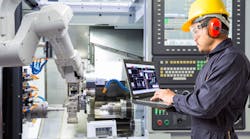What Should Safety Professionals and Systems Integrators Know about Robotics and Safety?
Keeping on-trend with its September Robotics Week, RIA hosted its International Robot Safety Conference (IRSC) virtually. 2020 has been a record-breaking year—for both good and bad. Jeff Pratt, EHS engineer of Tenneco Federal-Mogul Powertrain, discussed ways that users need to be concerned with robot safety in a year that has seen the best value for robot implementation.
Most topics Pratt highlighted in his discussion were directly related to the COVID-19 pandemic. For example, robotics can be used to reinforce facial covering and social distancing protocols.
“COVID has made everything exponentially harder than it needs to be,” said Pratt. He talked about how Pepper the robot was used to cheer at now-empty sports arenas. The programmable robot, noted Pratt, was also programmed to remind people to put on facial coverings in public.
Apart from the obvious COVID-related tasks robots can perform, there are certain trends that robotic safety professionals like Pratt see emerging from companies that desire a robotic solution. Companies typically look for robots for three tasks: dirty, dull and dangerous.
“If we’ve learning anything from COVID, it’s that we’re vulnerable,” he said. “We’re the part that needs to be protected.”
Pratt also said that when companies look for a robotic solution, it’s frequently not a response to a safety request. It’s to improve production and throughput. He noted that industrial, collaborative and mobile robots can help with social distancing guidelines as well.
Safety considerations for robotic implementation for these categories include:
- Ergonomic conditions for loading and unloading a robotic cell
- How the robotic application will affect the facility
- Upset conditions
Robotic Systems Integrators
In a separate IRSC presentation, Craig Salvalaggio, COO of Applied Manufacturing Technologies and Gerd Walter, president and COO of Creative Automation, discussed best practices, safety considerations and risk assessments for robotic systems integrators.
The first part of the presentation described how system integrators can define themselves and stand out among all their competitors. The RIA Certified Integrator Program confirms a given integrator has met certain qualifications, including risk assessments, having one expert and two technologists on staff, and scoring on 25 requirements. The program allows end-users to find and evaluate partners.
“We all play in the same space, but we can still learn from one another,” said Salvalaggio.
End-users can either choose a partner or self-integrate. With respect to the latter, Salvalaggio highlighted four questions end-users must ask themselves before becoming their own integrator:
- What are your in-house capabilities?
- Do you have the time and resources?
- Do you have application experience?
- Are you up to date on the latest safety standards?
Qualifying criteria for selecting an integrator include trust and long-term capabilities, testimonials, stability in the business, application and engineering experience, program management, support, warranty, safety and training.
“At the end of the day, it’s really about best practices from an integrator standpoint,” Salvalaggio said. “Every integrator should really strive to lead in the field—to differentiate from the competition.”
Walter spoke to how integrators use standards to develop safe and effective robot cells. While there are well-known industry standards, voluntary standards are also important. Integrators, he noted, undergo a lot of internal education.
“This is one of the values that systems integrators provide to end customers,” Walter said. “We have a lot of internal expertise.”
Since robots pose numerous safety hazards based on robot design, intended application and user interaction, risk assessments are crucial to ensure the safety of the workers (and mandatory for groups like the RIA Certified Integrator Program).
Walter highlighted the steps for a risk assessment, noting the original assessment is meant to be performed as if there are no safety systems present.
- Define the system and processes in which the robot cells operate
- Identify tasks and hazards
- Evaluate associated risk
- Reduce risk
- Verify risk has been reduced
- Document everything
“The risk assessment is a living document,” Walter said. “It stays alive for the life of the project, and indeed you give it to the customer…If they start changing things around, they have to redo the risk assessment.”
